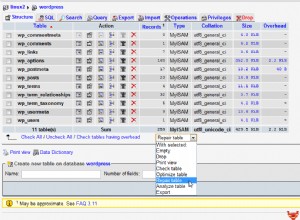Aby przechwycić komunikat o błędzie i jego kod:
do $$
begin
create table yyy(a int);
create table yyy(a int); -- this will cause an error
exception when others then
raise notice 'The transaction is in an uncommittable state. '
'Transaction was rolled back';
raise notice '% %', SQLERRM, SQLSTATE;
end; $$
language 'plpgsql';
Nie znalazłem jeszcze numeru linii
AKTUALIZACJA, 16 kwietnia 2019 r.
Zgodnie z sugestią Diego Scaravaggi, dla Postgres 9.2 i nowszych użyj UKOŃCZ diagnostykę :
do language plpgsql $$
declare
v_state TEXT;
v_msg TEXT;
v_detail TEXT;
v_hint TEXT;
v_context TEXT;
begin
create table yyy(a int);
create table yyy(a int); -- this will cause an error
exception when others then
get stacked diagnostics
v_state = returned_sqlstate,
v_msg = message_text,
v_detail = pg_exception_detail,
v_hint = pg_exception_hint,
v_context = pg_exception_context;
raise notice E'Got exception:
state : %
message: %
detail : %
hint : %
context: %', v_state, v_msg, v_detail, v_hint, v_context;
raise notice E'Got exception:
SQLSTATE: %
SQLERRM: %', SQLSTATE, SQLERRM;
raise notice '%', message_text; -- invalid. message_text is contextual to GET STACKED DIAGNOSTICS only
end; $$;
Wynik:
NOTICE: Got exception:
state : 42P07
message: relation "yyy" already exists
detail :
hint :
context: SQL statement "create table yyy(a int)"
PL/pgSQL function inline_code_block line 11 at SQL statement
NOTICE: Got exception:
SQLSTATE: 42P07
SQLERRM: relation "yyy" already exists
ERROR: column "message_text" does not exist
LINE 1: SELECT message_text
^
QUERY: SELECT message_text
CONTEXT: PL/pgSQL function inline_code_block line 33 at RAISE
SQL state: 42703
Oprócz GET STACKED DIAGNOSTICS jest zgodny ze standardem SQL, jego zmienne diagnostyczne (np. message_text ) są kontekstowe tylko dla GSD. Więc jeśli masz pole o nazwie message_text w twojej tabeli nie ma szans, że GSD może kolidować z wartością twojego pola.
Jednak nadal nie ma numeru linii.




